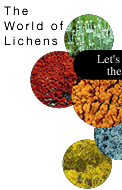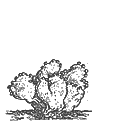

‘Species of lichens in fear of extinction
@Although many of lichens can endure tough environments such as those
of deserts, the antarctic region, and high altitude (where there are a
wide range of temperature changes and extreme desiccation), they are extremely
vulnerable to changes in the environment brought by air pollution and
urbanizationD Slight changes in their habitat may lead them to perish
or cause a decrease in their numbers to the extremity. Such delicate characters
of lichens entitle them to be the indicator plant for the measurement
of air pollution.
@Main factors which trigger the extinction of lichens are:
1) increase in the concentration of sulfur dioxide in the air. (In Tokyo
area, if the concentration of the gas excess 0.02 ppm, Parmelia (s.lat.)
would be declined).
2) arid condition caused by man-made environment
3) cutting of trees from natural forests
@In 1997, the Ministry of Environment announced a Red List of Plants. Of
the lichens found in Japan, 82 species are classified as the endangered
species in the list. Among 82 species, 3 are already considered extinct.
22 are in Phase I, i.e., they face difficulty surviving if aggravating
factors bringing about the persisting condition continue to affect them.
23 are in Phase II , i.e., they are likely to join Phase I if the aggravating
factors bringing about the persisting condition continue to affect them.
17 species have a small risk of extinction at this moment. But as the condition
of their habitat changes, they may incline to follow those of Phase II
or even move up to Phase I. The remaining 17 taxa are considered as being
rare but they possess very little data.
@In the updated Red List issued in 2017 by the MInistry of Environment,
153 taxa in total are listed. They are: 4 are extinc, 41 are in Phase I,
20 are in Phase II, 42 are in vulnerable. The remaining 46 taxa are lacking
data.
The revised Red List 2017 [see Lichens pp. 124-127] issued by the Ministry of Environment.
